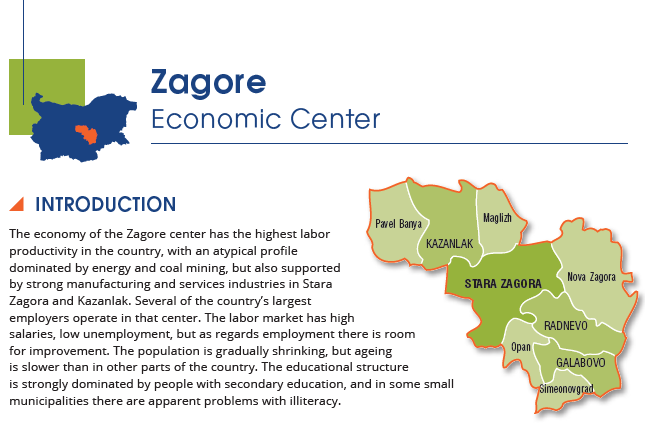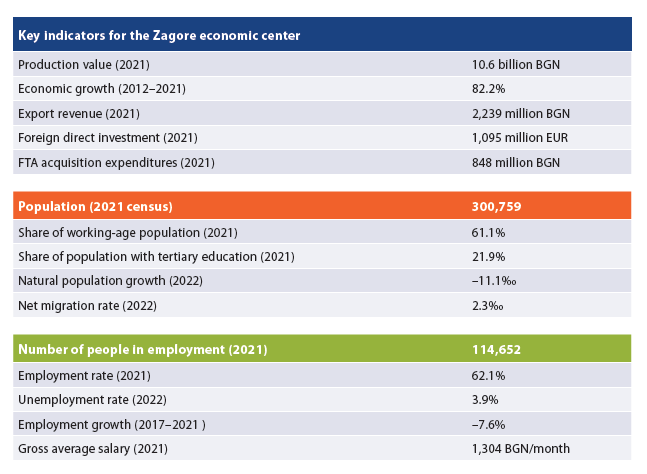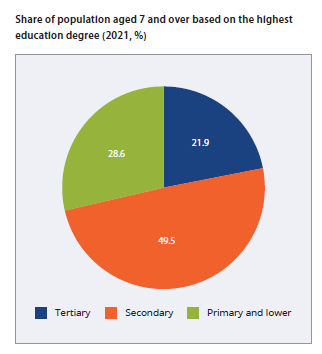Zagore Economic Centre
ZAGORE ECONOMIC CENTER
- INTRODUCTION | Key indicators for the Zagore economic center


- COMPOSITION AND LABOR MIGRATION
The Zagore center consists of four cores – Stara Zagora, Radnevo, Galabovo and Kazanlak, and five peripheral municipalities – Opan, Maglizh, Pavel Banya, Nova Zagora and Simeonovgrad. The municipality of Maglizh falls within the periphery of both Stara Zagora and Kazanlak, while Galabovo and Radnevo are included in the range of the center since they attract a large number of workers – a total of 4,500 people commute to them every day. In relative terms, the labor markets of Stara Zagora and Opan are the most closely linked ones, with 31% of workers from the periphery travelling to the core. The center is also distinctive in that it includes municipalities from three administrative districts – Haskovo, Stara Zagora and Sliven.
- ECONOMY AND INVESTMENT
 The total production value of the economic center in 2021 reached 10.6 billion BGN, or 35,300 BGN per capita. Value added growth over the last decade is 82%, which is among the highest in the country. Due to the leading role of energy production and mining, the municipality with the highest value added is Radnevo – 34% of the total for the center, followed by Stara Zagora with 30%, Kazanlak with 17% and Galabovo with 14%. Due to the NSI confidentiality rules, which do not allow the publication of certain data, the exact share of some key sectors in the value added for the municipality of Radnevo is not known, but taken together, mining and energy account for a total of 53% of value added in the center. Manufacturing also plays a significant role with a share of 23%, concentrated mostly in Stara Zagora and Kazanlak, and trade generates 12% of value added. Some of the largest employers not only in the region but also in the whole country operate in the center – the Arsenal weapons factory employs 7,200 workers, Maritsa-Iztok Mines – 6,900 people, several companies of the Troyanovo mine – 5,200 people.
The total production value of the economic center in 2021 reached 10.6 billion BGN, or 35,300 BGN per capita. Value added growth over the last decade is 82%, which is among the highest in the country. Due to the leading role of energy production and mining, the municipality with the highest value added is Radnevo – 34% of the total for the center, followed by Stara Zagora with 30%, Kazanlak with 17% and Galabovo with 14%. Due to the NSI confidentiality rules, which do not allow the publication of certain data, the exact share of some key sectors in the value added for the municipality of Radnevo is not known, but taken together, mining and energy account for a total of 53% of value added in the center. Manufacturing also plays a significant role with a share of 23%, concentrated mostly in Stara Zagora and Kazanlak, and trade generates 12% of value added. Some of the largest employers not only in the region but also in the whole country operate in the center – the Arsenal weapons factory employs 7,200 workers, Maritsa-Iztok Mines – 6,900 people, several companies of the Troyanovo mine – 5,200 people.
As of the end of 2021, the total amount of foreign investment in the center reached 1.1 billion EUR, concentrated mainly in the municipality of Galabovo – 65% of all FDI, almost entirely in the energy sector. The distribution of FTA acquisition expenditures is more even, with 42% of the total 848 million BGN invested in 2021 in industry, and 19% in trade, transport and tourism. Investment activity is concentrated in Stara Zagora, where 46% of the expenditures for the purchase of machinery, land and buildings are made; another 21% are in Kazanlak, and 5% – in Radnevo. Export revenues are low compared to the size of the local economy – 2.2 billion BGN, but this does not include the export of electricity produced by the enterprises in the center. Due to the structure of the economy with its strong dominance of energy and mining, the Zagore center has the highest labor productivity of all the 16 centers in the country – 29,500 BGN of value added per employee per year.
- LABOR MARKET
In 2022, the average unemployment rate was 3.9%, according to the Employment Agency data, considerably higher in Simeonovgrad (13%) and Maglizh (7.2%). In some of the smaller municipalities, there is a significant share of long-term unemployed, with 6% of employable people registered with the labor offices for more than a year in Simeonovgrad and 1.6% in Opan. Youth unemployment is also relatively high – the share of the unemployed among the population aged 15–29 is 2.5% in Radnevo and Galabovo and 6% in Simeonovgrad. The employment rate is among the highest in the country – 62.1% of the working-age population, but ranges from 41.7% in Simeonovgrad to 67.4% in Stara Zagora. Most employed persons are concentrated in Stara Zagora – 61,000 people, with another 26,000 in Kazanlak.
Over the last 5 years, there has been a relatively rapid shrinking of employment, with the number of people employed in the center down 7.6% since 2017. Due to the data confidentiality issues mentioned above, we cannot estimate the shares of energy and mining in the total employment figure. Manufacturing employs 37% of all employed people, followed by trade at 16%. In terms of territorial distribution, 47% of the people employed are in Stara Zagora, 25% – in Kazanlak, and among the two “energy” cores, the larger one is Radnevo with 14% of all employed in the center.
The average salary has had the slowest growth – by 39.8% – among all the 16 economic centers during the last 5 years and has reached to 1,304 BGN per month, as a result mostly of the high base at the beginning of the period. The center includes two of the municipalities with the highest average salaries in the country – Radnevo (2,040 BGN per month in 2021) and Galabovo (1,985 BGN per month). The highest salaries in Stara Zagora are also in the energy sector (2,259 BGN per month), as well as in culture, sports and entertainment (1,929 BGN per month), while in Kazanlak they are in health care (1,882 BGN per month).
- HUMAN RESOURCES AND WORKFORCE
 In the period between the last two censuses, the population of Zagore decreased by 12% to 301,000 people. The proportion of people aged 65 and above is 24%, which is close to the national average, with only the municipality of Opan quite noticeably ageing (43%). Demographic replacement indicators also show relatively slower ageing. In 2021, the share of the working-age population was 61%, or 184,000 people, 91,000 of them in Stara Zagora, another 40,000 in Kazanlak, and 17,000 in Nova Zagora.
In the period between the last two censuses, the population of Zagore decreased by 12% to 301,000 people. The proportion of people aged 65 and above is 24%, which is close to the national average, with only the municipality of Opan quite noticeably ageing (43%). Demographic replacement indicators also show relatively slower ageing. In 2021, the share of the working-age population was 61%, or 184,000 people, 91,000 of them in Stara Zagora, another 40,000 in Kazanlak, and 17,000 in Nova Zagora.
Taken as a whole, the municipalities in the center attract migrants, with an average net migration rate of 2.3‰ in 2022. However, those attracting population are only Stara Zagora, Kazanlak and Nova Zagora, while the rest of the center, including the other two cores, has a negative net migration rate. The natural growth rate of the center is –11.1‰, which is close to the national average, but it is significantly worse in Radnevo (–16‰), Galabovo (–19‰) and Opan (–33‰).
The Zagore center has a specific educational structure: according to the census data, the share of university graduates is 22% of the population aged 7 and older, and the share of people with primary and lower education – 29%. This in turn means that the majority of the population – and of the workforce – has secondary education, largely to be expected given the profile of the local economy. However, there is a high illiteracy rate – 2.1%, most visibly in Maglizh (9.6%), which is among the municipalities with the highest illiteracy rate in the country. Students’ results are close to the national average, with an average score of Good 3.74 in the 2022 BLL matriculation examinations, and an average score of 31.8 out of a possible 100 in the NEA in mathematics at the end of 7th grade.
Latest news
REGIONAL AWARDS: Who is the most of the most among the regions 14.12.2025
For more than a decade, the Institute for Market Economics has been presenting the publication "Regional...
It's not just Sofia: where are the highest incomes and investments in the country 01.12.2025
In this year's edition of the IME study "Regional Profiles: Indicators of Development " 2025, the capital...
